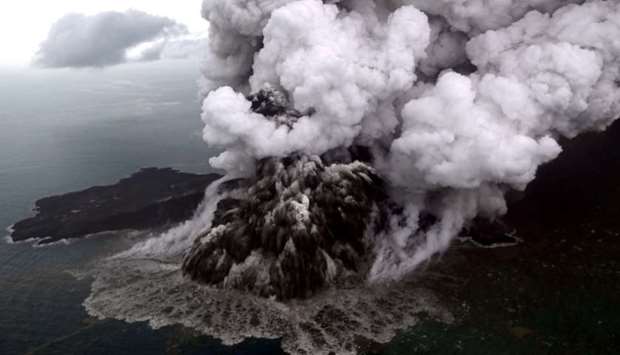National Disaster Management Agency spokesman Sutopo Purwo Nugroho said there was no tsunami warning in the Sunda Strait since Indonesia had yet to set up any early warning mechanism for a tsunami caused by landslides or volcanoes at sea.
He pointed out that the number of victims of the tsunami, which struck suddenly on Saturday evening about 9.30pm reached 222 people dead, 843 injured and 28 missing.
Tsunamis triggered by volcanic eruptions are relatively rare, caused by the sudden displacement of water or "slope failure," according to the International Tsunami Information Centre.
Unlike those caused by earthquakes, which trigger alert systems, these tsunamis give authorities very little time to warn residents of the impending threat.
The official explained that the water washed away hundreds of buildings on the southern coast of the island of Sumatra and west of the island of Java, and he expected further increase in the number of victims, especially in the absence of accurate information on all areas affected by the disaster.
Oxfam International, a non-governmental organisation that mobilised help, revealed that the residents of the small islands in Sunda Strait might be the most affected by the tsunami. Ambulance personnel are still searching for missing people among the rubble.
Dramatic video posted on social media showed a wall of water suddenly crashing into a concert by pop group "Seventeen" -- hurling band members off the stage and then flooding into the audience.
In a tearful Instagram post, frontman Riefian Fajarsyah said the band's bassist and road manager had been killed and his wife was missing.
Anak Krakatoa, which forms a small island in the Sunda Strait between Java and Sumatra, emerged around 1928 in the crater left by Krakatoa, whose massive eruption in 1883 killed at least 36,000 people and affected global weather patterns for years.
"The cause of the undersea landslide was due to volcanic activity of Anak Krakatoa, which coincided with a high tide due to the full moon," Nugroho told reporters in Yogyakarta.
Professor David Rothery from The Open University said that the proximity of the volcano to the coast gave authorities very little time to act.
"This is so close to the affected shorelines that warning time would have been minimal given the high speeds at which tsunami waves travel," he said.
Indonesian authorities initially said the wave was not a tsunami, but instead a tidal surge and urged the public not to panic.
Nugroho later apologised, saying because there was no earthquake it had been difficult to ascertain the cause of the incident early on.
"If there is an initial error we're sorry," he wrote on Twitter.
According to Indonesia's geological agency, Anak Krakatoa had been showing signs of heightened activity for days, spewing plumes of ash thousands of metres into the air.
Indonesia is one of the most disaster-prone nations on Earth due to its position straddling the so-called Pacific Ring of Fire, where tectonic plates collide.
Most recently in the city of Palu on Sulawesi island a quake and tsunami in September killed thousands of people.
On December 26, 2004 a tsunami triggered by a magnitude 9.3 undersea earthquake off the Sumatra coast in western Indonesia killed 220,000 people in countries around the Indian Ocean, including 168,000 in Indonesia.
US President Donald Trump was among world leaders to offer messages of support after the "unthinkable devastation" of Saturday's tsunami.
"We are praying for recovery and healing," he tweeted. "America is with you!"
The UN and European Union both pledged to mobilise humanitarian support if requested by Jakarta.
"The United Nations stands ready to support the ongoing government-led rescue and relief efforts," a spokesman for UN Secretary-General Antonio Guterres said in a statement.
The destructive wave left a trail of uprooted trees and debris strewn across beaches. A tangled mess of corrugated steel roofing, timber and rubble was dragged inland at Carita beach, a popular spot for day-trippers on the west coast of Java.
The International Federation of Red Cross and Red Crescent Societies said the "powerful waves" reached a height of 30-90cm (1-3ft).
Asep Perangkat said he was with his family when the wave surged through Carita, carving a swath of destruction, dragging cars and shipping containers.
"Buildings on the edge of the beach were destroyed. Trees and electric poles fell to the ground," he told AFP.
In Lampung province, on the other side of the strait, Lutfi Al Rasyid fled the beach in Kalianda city, fearing for his life.
"I could not start my motorbike so I left it and I ran... I just prayed and ran as far as I could," the 23-year-old said.
Kathy Mueller from the International Federation of Red Cross and Red Crescent Societies said the toll was likely to rise as the conditions on the ground became clearer.
"The situation, and the death toll, will remain fluid over the next days and even weeks."
Aid workers were helping to evacuate the injured and bring in clean water and tarpaulins to provide shelter, she added, saying the group was preparing for the possibility of diseases breaking out in the tsunami zone.
Heavy equipment was being transported to badly hit areas to help search for victims, and evacuation posts and public kitchens were being set up for evacuees, Nugroho added.
He pointed out that the number of victims of the tsunami, which struck suddenly on Saturday evening about 9.30pm reached 222 people dead, 843 injured and 28 missing.
Tsunamis triggered by volcanic eruptions are relatively rare, caused by the sudden displacement of water or "slope failure," according to the International Tsunami Information Centre.
Unlike those caused by earthquakes, which trigger alert systems, these tsunamis give authorities very little time to warn residents of the impending threat.
The official explained that the water washed away hundreds of buildings on the southern coast of the island of Sumatra and west of the island of Java, and he expected further increase in the number of victims, especially in the absence of accurate information on all areas affected by the disaster.
Oxfam International, a non-governmental organisation that mobilised help, revealed that the residents of the small islands in Sunda Strait might be the most affected by the tsunami. Ambulance personnel are still searching for missing people among the rubble.
Dramatic video posted on social media showed a wall of water suddenly crashing into a concert by pop group "Seventeen" -- hurling band members off the stage and then flooding into the audience.
In a tearful Instagram post, frontman Riefian Fajarsyah said the band's bassist and road manager had been killed and his wife was missing.
Anak Krakatoa, which forms a small island in the Sunda Strait between Java and Sumatra, emerged around 1928 in the crater left by Krakatoa, whose massive eruption in 1883 killed at least 36,000 people and affected global weather patterns for years.
"The cause of the undersea landslide was due to volcanic activity of Anak Krakatoa, which coincided with a high tide due to the full moon," Nugroho told reporters in Yogyakarta.
Professor David Rothery from The Open University said that the proximity of the volcano to the coast gave authorities very little time to act.
"This is so close to the affected shorelines that warning time would have been minimal given the high speeds at which tsunami waves travel," he said.
Indonesian authorities initially said the wave was not a tsunami, but instead a tidal surge and urged the public not to panic.
Nugroho later apologised, saying because there was no earthquake it had been difficult to ascertain the cause of the incident early on.
"If there is an initial error we're sorry," he wrote on Twitter.
According to Indonesia's geological agency, Anak Krakatoa had been showing signs of heightened activity for days, spewing plumes of ash thousands of metres into the air.
Indonesia is one of the most disaster-prone nations on Earth due to its position straddling the so-called Pacific Ring of Fire, where tectonic plates collide.
Most recently in the city of Palu on Sulawesi island a quake and tsunami in September killed thousands of people.
On December 26, 2004 a tsunami triggered by a magnitude 9.3 undersea earthquake off the Sumatra coast in western Indonesia killed 220,000 people in countries around the Indian Ocean, including 168,000 in Indonesia.
US President Donald Trump was among world leaders to offer messages of support after the "unthinkable devastation" of Saturday's tsunami.
"We are praying for recovery and healing," he tweeted. "America is with you!"
The UN and European Union both pledged to mobilise humanitarian support if requested by Jakarta.
"The United Nations stands ready to support the ongoing government-led rescue and relief efforts," a spokesman for UN Secretary-General Antonio Guterres said in a statement.
The destructive wave left a trail of uprooted trees and debris strewn across beaches. A tangled mess of corrugated steel roofing, timber and rubble was dragged inland at Carita beach, a popular spot for day-trippers on the west coast of Java.
The International Federation of Red Cross and Red Crescent Societies said the "powerful waves" reached a height of 30-90cm (1-3ft).
Asep Perangkat said he was with his family when the wave surged through Carita, carving a swath of destruction, dragging cars and shipping containers.
"Buildings on the edge of the beach were destroyed. Trees and electric poles fell to the ground," he told AFP.
In Lampung province, on the other side of the strait, Lutfi Al Rasyid fled the beach in Kalianda city, fearing for his life.
"I could not start my motorbike so I left it and I ran... I just prayed and ran as far as I could," the 23-year-old said.
Kathy Mueller from the International Federation of Red Cross and Red Crescent Societies said the toll was likely to rise as the conditions on the ground became clearer.
"The situation, and the death toll, will remain fluid over the next days and even weeks."
Aid workers were helping to evacuate the injured and bring in clean water and tarpaulins to provide shelter, she added, saying the group was preparing for the possibility of diseases breaking out in the tsunami zone.
Heavy equipment was being transported to badly hit areas to help search for victims, and evacuation posts and public kitchens were being set up for evacuees, Nugroho added.



